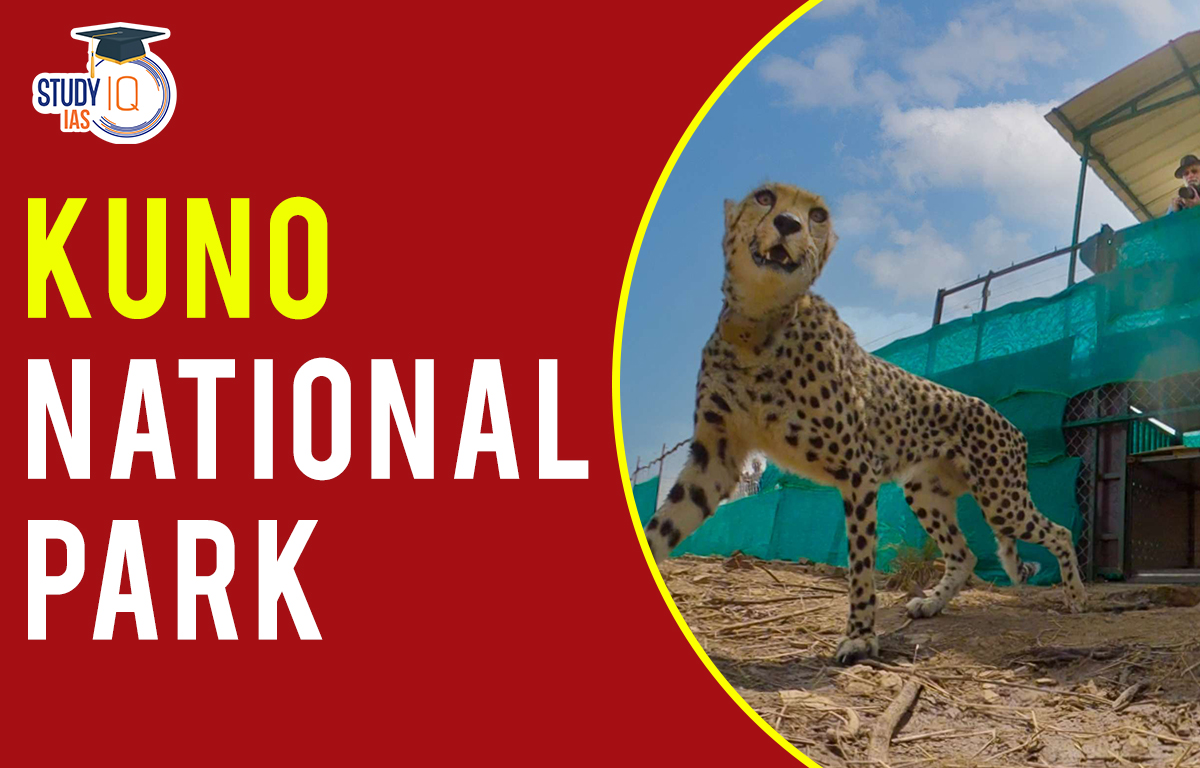Table of Contents
Kuno National Park
In Madhya Pradesh, India, there is a national park and wildlife sanctuary called Kuno National Park. The Kuno River is where it gets its moniker. With an initial size of 344.686 km2, it was created in 1981 as a wildlife sanctuary in the districts of Sheopur and Morena. It received the designation of national park in 2018. Under the “Action Plan for Introduction of Cheetah in India, Kuno National Park was chosen. This article on kuno National Park will be very helpful for the UPSC Syllabus Environment and Ecology section. In this article candidate can find all the information related to Kuno National Park. To get more accuracy in the preparation of UPSC, candidates can go for the UPSC Mock Test provided by StudyIQ Education.
Kuno National Park Feature
In the Sheopur district of MP, Kuno National Park was created in 1981 as a wildlife refuge. It received the designation of national park in 2018. It is a component of the dry deciduous woodlands of Khathiar-Gir. The size of Kuno National Park is 748.76 square kilometres. The Kuno River, one of the Chambal River’s principal tributaries, runs the entire length of the National Park section.
Palpur-Kuno forest had been chosen as a finalist by the Wildlife Institute of India and the Wildlife Trust of India as a habitat for cheetahs and Asiatic lions. In 1948, cheetahs that once wandered the northern Indian plains went extinct. All four of India’s big cats may have communities within the Kuno. All four of these animals—the tiger, the leopard, the Asiatic lion, and the cheetah—have coexisted in the same environments. Historically, before overhunting and habitat devastation led to their depletion.
The only larger carnivores present in Kuno National Park at this time are the leopard and striped hyena, with the lone tiger T-38 having returned to Ranthambore early this year (2021). The Asiatic lion will eventually have a second habitat in India at the KunoPalpur Wildlife Sanctuary.
Kuno National Park Location
The size of Kuno National Park is 748.76 square kilometres. It is situated in Madhya Pradesh’s Sheopur region. Along its full length, the Kuno River, one of the Chambal River’s principal tributaries flows dividing the National Park division in half.
Also Read: Ranthambore National Park
Kuno National Park Fauna
Indian wolves, jackals, leopards, langur primates, blue-bull, chinkara, and spotted deer are all present in Kuno National Park. The Chital, Sambar, Nilgai, Wild pig, Chinkara, Chousingha, or Four-horned gazelle are among the park’s other animals. Here you can find blackbuck, Indian hare, Indian crested porcupine, and Southern grasslands grey langur.
Leopard, Sloth bear, spotted hyena, grey wolf, golden jackal, Indian fox, and Ratel are some examples of carnivores. Since leaving the Ranthambhore Tiger Reserve, only one male Panthera tigris (Tiger) has returned. Here, you can find small predators like the jungle cat, Indian grey mongoose, ruddy mongoose, and small Asian mongoose. The Kuno River has also seen sightings of the gharial.
Also Read: Gir National Park
Kuno National Park Cheetah Reintroduction Plan
The Department of Environment officially asked Iran, which at the time had 300 Asiatic cheetahs, for some cheetahs in the 1970s. Before a deal could be made, the Iranian Shah was overthrown. In 2009, attempts to reintroduce cheetahs to India were made once more, and the Wildlife Trust of India held a conference to talk about the viability of doing so. There were several options, but Kuno-Palpur National Park was deemed to be the most appropriate.
This was due to the area’s easily accessible large habitat area and the sizeable investments that had already been made to evict the local villagers from the location. The decision to reintroduce cheetahs to Kuno- Palpur was stayed by the Supreme Court in 2010 because the National Board for Wildlife was not informed of the situation. The court ruled that the reintroduction of the Asiatic lion, which is only located in Gujarat’s Gir National Park, should take precedence. In response to a government petition, the Supreme Court declared in 2020 that African cheetahs could be introduced on an experimental basis in a “carefully chosen location.”
Bhupender Yadav, India’s environment minister, unveiled the action plan for restoring cheetahs in the country in January 2022, with Kuno National Park as the first stop. Three of the eight cheetahs in Madhya Pradesh’s Kuno National Park were recently freed by Prime Minister Modi. These cheetahs were brought in from Windhoek, the nation of Namibia. Eight untamed cheetahs were transported to India, five of which are female and three of which are male. In the next five years, about 50 cheetahs will be released into the wild.
Kuno National Park UPSC
The government only changed Kuno National Park’s designation from a wildlife sanctuary to a national park in 2018. It was first created as a wildlife sanctuary. Kuno is mainly a grassland area and is named after the Kuno River, one of the major tributaries of the Chambal River, which crosses it. Under the “Action Plan for Introduction of Cheetah in India,” Kuno National Park was chosen. Read all about UPSC Exam preparation by visiting official website of StudyIQ UPSC online Coaching.


 Nilgiri Biosphere Reserve, Map, Climate,...
Nilgiri Biosphere Reserve, Map, Climate,...
 Repo Rate and Reverse Repo Rate, Impact ...
Repo Rate and Reverse Repo Rate, Impact ...
 Foreign Contribution Regulation Act (FCR...
Foreign Contribution Regulation Act (FCR...





















